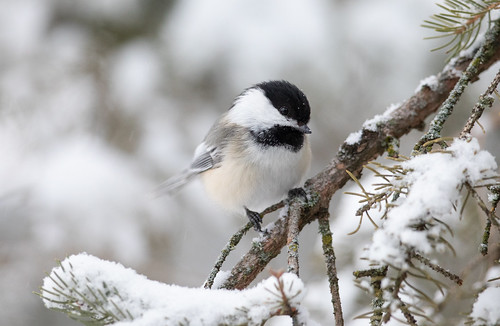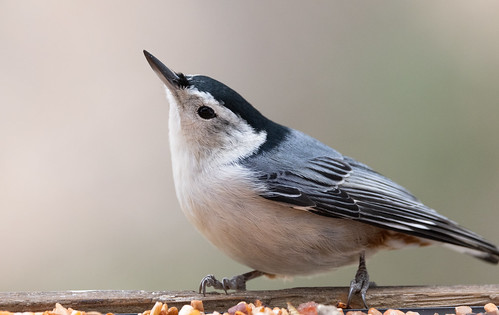 |
| Robins arrived this year while redpolls were still everywhere. |
Any time I hear a robin’s song, so rich and bubbly, my heart fills with joy. Our species has no idea what exactly robins are communicating to one another, but our own ears tease out words like cheerily, cheerily, and spring is here. The first robin song I hear after a long winter is balm to my soul. At that moment, I know this is my most beloved song.
Until I remember how much I enjoy hearing chickadee songs in the dead of winter. There’s nothing like that Hey, sweetie! to lift my spirits when the temperature is double digits below zero.
This year, especially in the past couple of months, the exuberant twitterings of redpolls have been bringing me a lot of joy, too. Decades ago, when we saw large irruptions of redpolls more regularly, the flocks always seemed to build until mid- or late-April or the very start of May, and then the birds would vanish for the year. I knew that would be the likely pattern this year, but I was still surprised to have so many in my yard still on Easter Sunday—that’s when I got my very best recording ever of this lovely finch.
In the background, I heard something even more welcome. The bird song I associate most with mid-April snowfalls is the Fox Sparrow, and I have about 20 visiting my yard right now. Their songs are at an ideal frequency for my hearing—I can hear nearby Fox Sparrows through the window or whenever the door opens, and the sound is wonderfully pleasing, managing to strike plaintive and cheerful chords both. I’d feel bereft in early May when the last Fox Sparrows disappeared if not for the House Wrens, Brown Thrashers, catbirds, Rose-breasted Grosbeaks, and orioles that start to arrive at that point.
Not all the pleasures of spring are auditory. A couple of weeks ago, I noticed that one of my chickadees had lost all its tail feathers. That’s usually from a run-in with a predator. Injuries beyond that sometimes doom a poor bird, but this one is doing fine, the feathers more than half grown in again already. When feathers are damaged or broken away from the body, they don’t repair themselves—not until new feathers grow in during molt can that kind of damage be fixed in nature. But when feathers are pulled from the roots, as long as the bird has enough food, the feathers grow in surprisingly quickly. It took a few days between my noticing this bird and being able to get some photos, and by then the tail was already a good inch long.
A couple of Blue Jays hung out in the neighborhood this winter, but only occasionally came to my yard. Now, at least one of “my” Blue Jays is back—I can tell, because if I go out with a few peanuts, it immediately flies in and grabs them. I’m hearing crows every day, but the pair must be nesting further from my yard this year, so I’m not seeing them much.
I need to spend time in my yard trying to figure out where my White-breasted Nuthatches are nesting. It’s probably fairly close to the house—maybe in one of my box-elders or maples because the male is singing so vociferously every morning right now. While I was still putting out Nyjer seed in my office window feeder and the feeder was crowded with redpolls, my chickadees would hold back while the redpolls were there. Not my male nuthatch—he flies straight into the bunch and they scatter. His mate is more reticent—she waits until he leaves and grabs what she can before the redpolls take over again.
Frigid temperatures and snow can make us doubt spring is ever going to arrive, but if we bundle up, close our eyes, and open our ears, we can savor the rich and constantly changing spring symphony. No matter which instruments have the leading part on a given day, the cheapest concert of the year invariably turns out to be the greatest.







